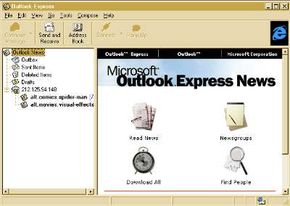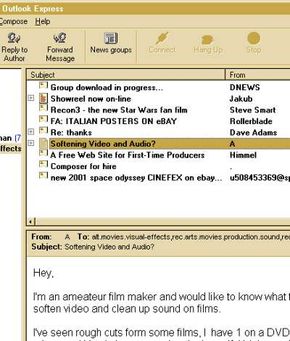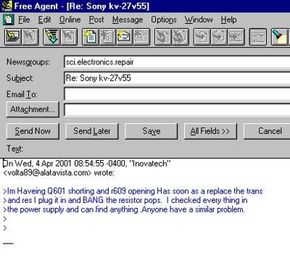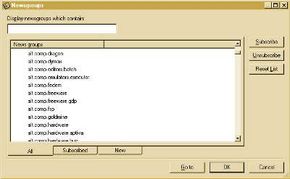Along with e-mail, newsgroups are one of the oldest communication methods on the Internet. But there are many ways to communicate on the Web. You probably use more than one method, depending on your needs. Let's take a look at the different methods and when you might use them:
E-mail - By far the most popular means of communicating over the Internet, e-mail allows you to send a message directly to another person or group of people. Messages can range from short to long and may include quotes or attached files. You can learn more about e-mail in the article How E-mail Works. E-mail is most effective when:
- You don't need an immediate answer.
- You are communicating with a single person or specific group of people.
- You know with whom you wish to communicate.
- You need to attach a file or provide extensive information.
Chat - Chat is a conversation between two or more people that takes place in a chat room. The chat room software allows a group of people to type in messages that are seen by everyone in the "room." Chat rooms can be found all over the Internet, including on the America Online service and the Web site TalkCity.com.
Chat is most effective when:
- You need an immediate answer.
- You want to communicate with more than one person.
- You can communicate in brief messages the information you need to know or wish to provide.
- You want to meet new people.
Instant messages - Instant messaging is something of a cross between chat and e-mail. It allows you to maintain a list of people that you wish to interact with. You can send messages to any of the people in your list, as long as that person is online. Sending a message opens up a small window where you and your friend can type in messages that each of you can see.
Instant messages are most effective when:
- You need an immediate answer.
- You only need to communicate with a single person or small group.
- You know with whom you wish to communicate.
- You need to communicate in real time.
Newsgroup - As stated earlier, a newsgroup is a continuous public discussion about a particular topic. Newsgroups are decentralized, which means that the messages are not maintained on a single server, but are replicated to hundreds of servers around the world.
Newsgroups are most effective when:
- You don't need an immediate answer.
- You want to communicate with more than one person.
- You want to communicate with a group of people interested in the same topic.
- You need or want to provide extensive information about that topic.
Forum/Discussion Board - Forums and discussion boards are very similar to newsgroups, with one major difference: Most forums and discussions boards are kept on a single server maintained by the owner or originator of the forum or discussion board.
Forums or discussion boards are most effective when:
- You don't need an immediate answer.
- You want to participate in a community that is discussing a particular topic.
- You want to communicate with a group of people interested in the same topic.
- You need or want to provide extensive information about that topic.
Listserv - Most of us probably belong to one listserv or another. Every time you register for a newsletter, such as the free HowStuffWorks newsletter, you are placed on a listserv. Basically, this is a type of broadcast e-mail. Information on a listserv is sent to everyone who is listed in the e-mail group on the server. The biggest difference between a listserv and a newsgroup is that listservs are not interactive.
Listservs are most effective when:
- You don't need an immediate answer.
- You want or need regularly updated information about a particular topic.
- You want to receive information from a group of people interested in the same topic.
Conferencing - Conferencing is like a chat room on steroids. The conference software, such as Microsoft Netmeeting, allows you to have a real-time chat with one or more other users. It also allows you to do such things as share an electronic whiteboard or a software application. Most conferencing-software packages provide several means of communication, including text only, audio and even video.
Conferencing is most effective when:
- You need an immediate answer.
- You want to communicate with more than one person.
- You can communicate in brief messages the information you need to know or wish to provide.
- You want to attach files or use the whiteboard function in addition to sending and receiving traditional text messages.
Video - Some users take advantage of a fast connection, such as a cable modem or DSL, in conjunction with a Webcam to communicate by way of video. This method of communication is not common yet, but will probably increase in popularity as the number of users with high-speed connections increases.
Video is most effective when:
- You need an immediate answer.
- You want to visually demonstrate or display information.
- You and the people you are connecting to have fast connections.
IP Telephony - Another emerging communications technology is IP telephony, which uses the Internet in much the same way that a regular telephone uses a phone line. Most IP telephony software requires that each person who wishes to talk have a computer, Internet connection and special software. But some companies, such as Net2Phone, provide software that allows you to call someone directly over the Internet and connect to that person's normal phone.
IP telephony is most effective when:
- You need an immediate answer.
- You have the appropriate equipment (speakers, sound card and microphone).
- The information you are providing or requesting is easier to convey through talking than through text messaging.
Most of the methods described above require some type of client software on your computer. In most cases, the client software is either free or integrated with another software application. For example, Netscape Navigator and Microsoft's Internet Explorer and Outlook Express each includes a newsgroup reader client that you can use to subscribe to newsgroups. We'll talk more about subscribing to newsgroups later.




